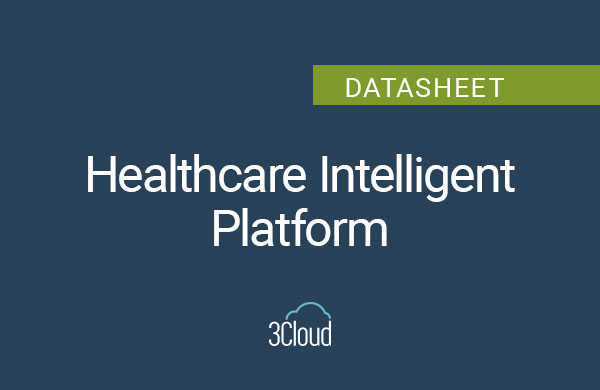Large moves can be daunting, exciting and take a lot of organization. Think about the last time you moved into a new apartment or a home. Starting a fresh, new beginning can be invigorating, but the process of packing all your belongings, the energy it takes to move boxes and heavy furniture, keeping track of all of your possessions, setting up all your and managing this task along with your other day-to-day activities can be challenging.
Similar to moving living situations, a cloud migration strategy can take a lot of time, skill and expertise. A cloud migration strategy is a plan set in place by an organization to transition existing on-premises and co-located application workloads and their respective data to the cloud.
The success of a cloud migration boils down to the strategy to transition these applications. To tie it back to our earlier moving analogy, consider 3Cloud your trusted movers to make the process seamless, efficient and tailored to you.
We help oversee and facilitate the multi-faceted complexities of a cloud migration. But even more complicated than a traditional move, a successful move to the cloud requires prioritizing your initiatives, identifying opportunities for savings, understanding true costs and responsibilities, estimating the duration of the project, staying on budget, assisting stakeholders in understanding complex data and ensuring that your future cloud infrastructure can support your business goals.
Understanding Cloud Migration
What is cloud migration and what are its benefits? Cloud migration is the operation of moving a business’s data, applications and other elements from their local infrastructure to a cloud environment. Consider your family photographs for instance – it is wonderful to have physical copies to have and look through, but if your basement floods, it would be heartbreaking to lose them. Similarly, losing important materials for your business can be detrimental. Having a reliable backup outside of data centers, computers or hard drives is essential for the security and function of your company. A hiccup in a data center from a local power outage can put a whole company out or work for a day or more, while a cloud environment would allow people to work from additional locations with full access to all of their necessary work materials.
Beyond security and reliability, a cloud platform assists in several other aspects of business. A cloud environment sets a business up for success through accessibility, scalability, flexibility and agility. A cloud environment hosts all business information without data limits– and the magic of the cloud is that it is readily available to anyone with granted access simply through an internet connection. This allows for immense flexibility in the work environment and makes remote collaboration a breeze. Accessible information also empowers employees by equipping them with the resources they need. From a managerial perspective, digital assets can be delegated based on fluctuating workloads with ease. On the flexibility front, a cloud strategy allows for businesses to deploy additional applications and quickly adjust according to evolving business requirements.
A cloud environment positions companies for success by enhancing security, reliability, accessibility, flexibility and more.
The Need for Cloud Migration
For companies with legacy systems, the transition to cloud-based solutions can be a big, yet impactful, move. A legacy system or software application is outdated and restrictive for a variety of reasons. Older technologies prevent growth and expansion since they may not interact with modern systems – holding companies back and creating an easy opportunity for them to be surpassed by competitors that are able to be more agile, flexible and unified.
Becoming cloud based allows for greater business continuity. By having information stored in multiple, easy to access areas, cloud computing is essential in emergency situations and for everyday use. During disruptions, cloud environments host access to information, allowing for business as usual. With real time, updated access to digital assets and analytics, workforces can make informed decisions and stay informed on business messaging.
Remote work has increased dramatically in recent years. Cloud computing provides improved collaboration for people working remotely and in-office. Additionally, by having a full workforce on the same page and being able to access all the essential materials and tools, cloud computing leads to overall increased productivity.
Key Considerations Before Migrating
With all these competitive advantages to a cloud strategy, you may be eager to get started, but there are a few important aspects to consider before you start your cloud migration. Assessing business objectives and requirements is crucial and will indicate the path of your migration strategy. While cloud environments can universally enhance businesses, the specific cloud migration strategy should be tailored to each company.
What are the specific needs of your business? Understanding what your organizational goals are ensures everyone is aligned and increases operational efficiency. For instance, not every application is suitable for migration since not every application used by a workforce is suitable for a cloud environment. An important step before beginning your cloud migration is putting together a detailed analysis of the applications in use’s architecture, dependencies, and key metrics in order to determine which applications need to migrated and how to optimize them for the cloud computing system.
In order to transition your business to the cloud effectively, it’s important to prioritize addressing security and compliance requirements from the start. Ensuring your cloud infrastructure aligns with regulatory standards is crucial for safeguarding sensitive data and maintaining customer trust.
Additionally, conducting a thorough financial analysis is pivotal before the migration phase begins – this entails estimating costs, potential savings, total cost of ownership and expected return on investment. This thorough evaluation lays the foundation for a robust migration strategy.
Another important aspect in assembling a skilled migration team is having experts that are proficient in cloud technologies onboarding, can streamline the migration process and mitigate potential disruptions. Leveraging their expertise can significantly enhance the success of your company’s cloud migration.
It’s essential to also evaluate the infrastructure options of a cloud provider. To do this, a business should compare key criteria like cost, scalability, security, performance, management complexity, compliance and other needs. From there, a business can begin to investigate leading public cloud providers and compare offerings.
Moving Your Data to the Cloud
For every user to have the best experience and get off on the right foot, a smooth transition with minimal downtime is quite significant – and it comes down to several key processes. One of the main things to nail down is putting effective change management procedures in place. These processes are essential for navigating the complexities of migration, helping to streamline alterations and maintain control throughout the transition.
Another major aspect is communication. Maintaining open and continuous communication with stakeholders and end-users helps everyone get on the same page, manages expectations and keeps all parties informed about progress and any potential disruptions that may arise.
To protect against the risk of data loss and downtime, it’s important to implement redundancy and failover mechanisms. These serve as a safety net in case of system failures, providing an extra layer of protection for your data and operations.
Before fully committing to the migration, a business should undergo testing and validation. This ensures that all systems operate seamlessly in the new environment, which minimizes the risk of unexpected issues arising during the cloud transition.
Once the migration is complete, it’s essential to keep monitoring performance – continuous monitoring nurtures a cloud environment. Any issues that arise should be addressed promptly, fostering a cloud environment that is both resilient and efficient.
Developing Your Strategy Together
A successful cloud migration strategy has many layers – including personalization, assessing business objectives, auditing your company’s applications, understanding finances, comparing infrastructures and so much more. A well done cloud migration strategy offers companies a tremendous competitive advantage due to increased security, reliability, accessibility, flexibility and cost effectiveness.
It’s crucial to have an experienced and trusted partner in your corner to tailor this transition to your company, assist in setting priorities, understand true costs and identify opportunities for savings, estimate the duration of the project, assist stakeholders in understanding complex data and ensure that your future cloud infrastructure can support your business goals.
3Cloud is a team of experts ready to make the cloud work for you. Get started to begin your cloud migration journey today.




